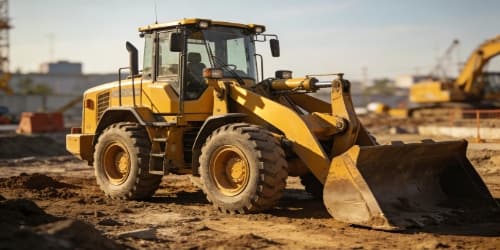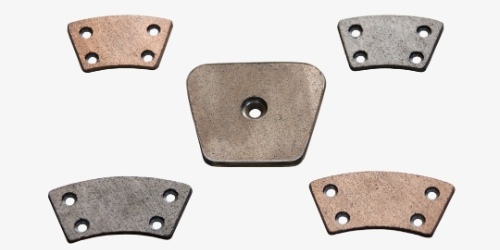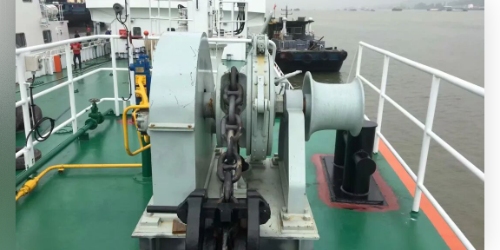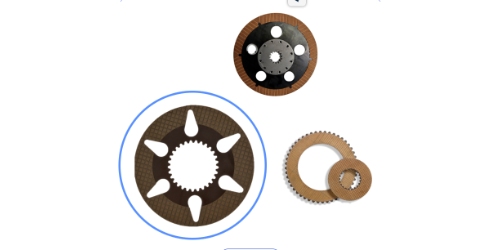About Us
Precautions for Replacing Forklift Clutch Friction Plates
Views : 110
Update time : 2025-10-17 15:04:00
Forklift clutch friction plates, also known as forklift clutch separator plates or clutch steel plates,can be categorised into inner friction plates and outer friction plates.They are components typically installed within the forklift clutch assembly.
The forklift's clutch primarily comprises components such as the clutch piston,end plate,drum wheel,disc drum,outer friction plates,inner friction plates,pressure plate,and springs.It features three wet-type shift clutches (two for gear shifting and one for directional reversal),which engage via hydraulic operation.
Function of Forklift Clutch Friction Plates
1.Transmission of rotational torque.The flywheel of the forklift engine serves as the driving component of the clutch.The driven plate,equipped with friction linings,and the driven hub are connected to the driven shaft (i.e., the input shaft of the transmission) via a sliding spline.The pressure springs then clamp the driven plate firmly against the end face of the flywheel.2. The torque from the forklift engine is transmitted to the driven plate via the frictional interaction between the flywheel and driven plate contact surfaces.It is then conveyed through the driven shaft and a series of components within the transmission system to the drive wheels.The greater the clamping force exerted by the pressure springs,the higher the torque the clutch can transmit.
Precautions for Replacing Forklift Clutch Friction Plates
1.The driven plate assembly must be kept clean,and the forklift clutch friction plates must be protected from dust,dirt and oil. Before installation on the engine,thoroughly clean the pressure plate and flywheel surfaces to remove any oil residue,thereby preventing clutch slippage.2. The forklift clutch is normally pre-adjusted at the factory and requires no further adjustment during installation.
3.To ensure smooth clutch operation,the clutch pressure plate assembly and driven plate assembly have been balanced prior to leaving the factory.Under no circumstances should components be arbitrarily replaced during use.Should disassembly be necessary for forklift clutch repairs,markings should be made beforehand. After servicing, reassemble according to the original markings and rebalance the assembly.
4.When fitting or removing the clutch on a forklift engine,the bolts or nuts securing the clutch to the flywheel must be alternately tightened or loosened diagonally.
5.When installing the clutch, apply heat-resistant and pressure-resistant grease to adequately lubricate the driven plate splines and the gearbox shaft splines,ensuring the driven plate can move freely along the gearbox shaft splines.Note that excessive lubrication may cause the forklift clutch friction plates to slip.
6.During installation, extreme care must be taken to avoid damaging the splines of the driven plate,preventing axial movement of the driven plate from becoming jammed due to burrs and thus failing to disengage.
7.It is imperative that the clutch disengagement travel of the forklift meets specified requirements.Excessive disengagement travel may cause the release rod to contact the driven plate,posing a hazard;insufficient disengagement travel will prevent the forklift clutch from disengaging completely.
8.When the clutch is engaged, a clearance of 2–3 mm must be maintained between the release bearing and the release ring.This allows the pressure plate to fully engage the friction plates even when worn,ensuring reliable transmission of engine torque.
9.The separation bearing must be able to slide freely on the gearbox first-shaft sleeve,so the sliding surfaces must be kept adequately lubricated and the sleeve must be correctly positioned.
10.When the forklift clutch friction plates wear down to the specified limit,promptly replace the driven plate assembly.This prevents clutch slippage and scratching of the pressure plate and flywheel surfaces.
11.Handle the forklift clutch with care when picking up or placing it;avoid dropping or knocking it.During handling,never grasp the release ring to avoid deforming the torsion springs.
12.Ensure correct operation to prevent clutch slippage caused by improper handling.Forklift operators must not keep their foot constantly on the clutch pedal.The clutch should be disengaged swiftly by depressing the pedal fully.When engaging,release the pedal as rapidly as possible while ensuring smooth engagement to prevent prolonged semi-clutch conditions.The following practices are prohibited:starting with high throttle and high gear;shifting up from low gear to high gear before sufficient speed is attained and then abruptly accelerating;repeated hill starts on steep inclines;or attempting to force the vehicle forward on muddy terrain where slippage or wheel sinking occurs by increasing throttle or using half-clutch.Such practices cause the clutch to overheat due to continuous intense friction,leading to burnt friction plates,warped pressure plates,or even thermal cracking,resulting in severe consequences.
13.During routine forklift maintenance,pay attention to inspecting the clutch release mechanism.Promptly rectify any pump or line leaks to ensure the clutch functions correctly.
相关新闻
 What consequences may arise from the deterioration of friction plates within a bulldozer's transmission?
What consequences may arise from the deterioration of friction plates within a bulldozer's transmission?
Dec 15,2025
Friction plates are critical to a bulldozer’s transmission, controlling speed and power output. Damaged or worn plates lead to unstable operation, accelerated wear of gears and bearings, increased downtime, and higher long-term costs. This article explains why timely replacement is essential for safety, performance, and extending your equipment’s lifespan.
 A Casual Discussion on Brake Pad Friction Materials
A Casual Discussion on Brake Pad Friction Materials
Dec 12,2025
A vehicle's braking system is as critical as its engine—your ultimate safety relies on the friction material within your brake pads. This article explores the science behind friction materials, explaining how complex formulations—comprising grinding fillers (e.g., zirconium silicate), wear reducers (graphite), and functional fillers—work together to balance performance factors like friction coefficient, noise, wear, and heat resistance. We break down common formulations (semi-metallic, ceramic, low-metallic, hybrid) and their ideal applications, debunking myths like judging quality by magnet attraction. True performance depends on R&D expertise and tailored formulations, not just material presence.
 Prevent Downtime! Marine Anchor Brake Band: Fault Diagnosis, Repair & Proactive Maintenance Solutions
Prevent Downtime! Marine Anchor Brake Band: Fault Diagnosis, Repair & Proactive Maintenance Solutions
Dec 08,2025
Marine windlass brake lining is a critical safety component for anchoring operations. This article provides a comprehensive overview of its key components (body, wheel, system, adjustment device), core functions in chain tension control and stability, common fault diagnosis methods (wear, system malfunction, overheating), step-by-step repair & replacement procedures, and essential preventive maintenance practices. Supported by real-world case studies, this guide offers valuable insights for ship operators and maintenance crews to ensure system reliability and prevent downtime.
 Key Technologies for Analyzing Agricultural Machinery Clutch Friction Plates
Key Technologies for Analyzing Agricultural Machinery Clutch Friction Plates
Dec 05,2025
Modern agricultural machinery clutch friction plates endure extreme friction and thermal loads in complex operating conditions, directly impacting transmission system reliability. Paper-based friction materials have emerged as the market mainstream due to their high friction stability, heat resistance, and lightweight properties. This analysis examines key failure modes—including mating surface roughness effects, overheating, and excessive pressure—while presenting professional solutions through material optimization, thermal design, and pressure control. As an expert in friction materials, we provide customized high-performance clutch plates for high-horsepower agricultural machinery, ensuring durable and stable operation.

